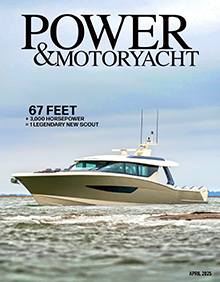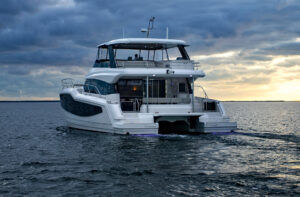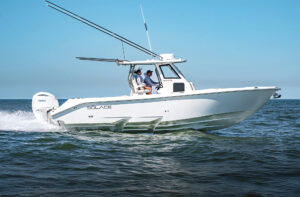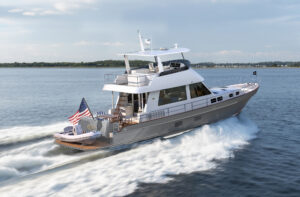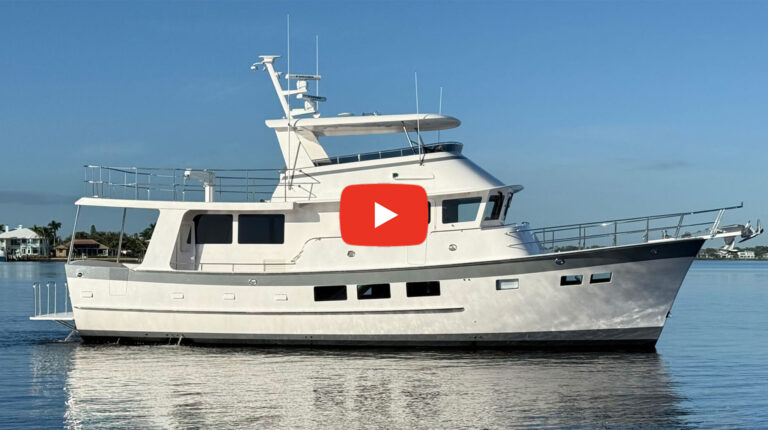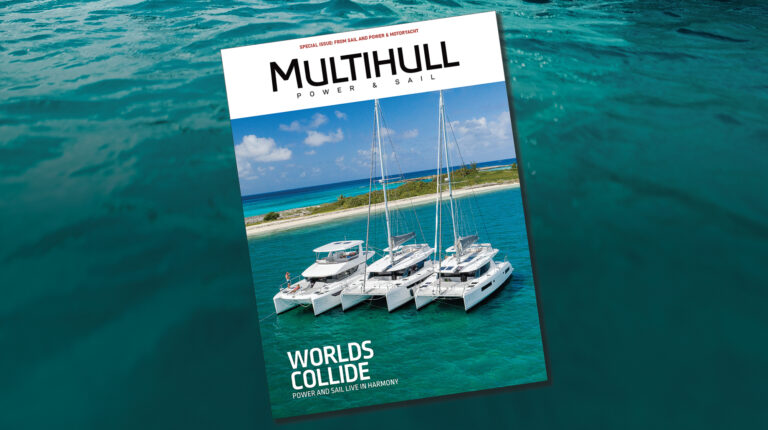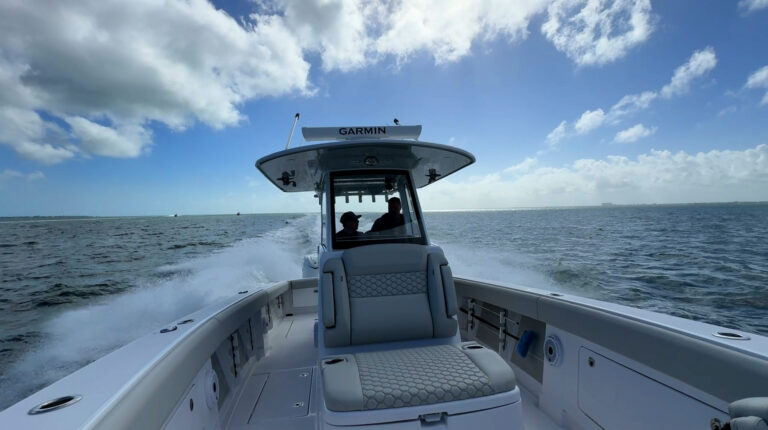Invincible 33
Thanks to computational fluid dynamics and some hard-won America’s Cup design savvy, this cat is likely to be loads of fun.

Invincible Boats began splicing a burgeoning fleet of power cats into its rousing repertoire of offshore monohull fishing machines about four years ago, and the Invincible 33, the most compact offering to date, is scheduled to launch within the next few months. Of course, one of Invincible’s major-league claims to fame, at least in terms of catamaran design is the “semi-asymmetrical” hull form. It’s a feature that, according to Invincible, makes its power cats easy to drive, fast and comfortably smooth, even under sporty conditions.
Semi-asymmetrical? What the company is getting at with this term is a little complicated. To begin with, the sponsons of most power cats are typically referred to as “symmetrical,” meaning each sponson is ample and therefore quite buoyant and the shape of the inner half replicates the shape of the outer half. On the flip side, you have the planing-type power cat. It’s considerably different in that the boat tends to have a lower, sleeker profile and sponsons that are generally termed “asymmetrical,” meaning the shape of the inner half is vertically flat or slab-sided, unlike the curvilinear shape of the outer half. Then finally, you’ve got the third variety of cat—boats like the Invincible 33. The 33’s sponsons are called “semi-asymmetrical” because they essentially split the difference between the other two aforementioned types, thereby tapping into the advantages of both.

“For the most part, what we’re aiming for with the semi-asymmetrical thing is pretty straightforward,” explains Pete Melvin of Morrelli & Melvin, the California-based multi-hull mavens that used a sophisticated, in-house computational fluid dynamics program to develop the 33, along with numerous other speedsters, over the years, including the rest of Invincible’s power-cat lineup as well as some decidedly high-profile America’s Cup screamers. “We want to create a sportfishing boat that offers the superior ride of the symmetrical power cat and, at the same time, the high-speed performance of the asymmetrical power cat.”
The complexities entailed in achieving this goal are best illustrated, perhaps, by briefly considering one particular aspect of open-water boat handling: turning at speed. Let’s delve a tad deeper into the design of the symmetrically hulled power cat for just a moment. At both high and low speeds, it tends to lean outboard while making a turn. A given vessel’s vertical center of gravity (VCG), the aerodynamic and hydrodynamic forces that hold sway within the tunnel between the boat’s sponsons and numerous other factors determine the intensity of the behavior.

Now let’s consider a well-designed, asymmetrically hulled power cat—a Douglas Skater, for example. At sporty rates of speed, Skaters will typically turn fairly flat corners, although steering, trim and throttle settings have to be finessed for safety’s sake. Again, a given boat’s VCG, the aerodynamic and hydrodynamic forces that hold sway within the tunnel (including a velocity-enhancing lift factor and critical influences from the slab sides just mentioned) and numerous other details determine the predictability and reliability of the behavior.
S, what about the Invincible 33? According to Melvin, because the inboard halves of her sponsons are neither slab-sided nor shaped to duplicate the outboard halves, a unique set of pressure differentials, buoyancy factors and other complicated forces are brought into play. And the fusion of these forces makes the boat turn slightly inboard at speed, very much like a mannerly, sea-chompin’ monohull, albeit one with an asymmetrical power cat’s wafty, high-performance speed and a symmetrical power cat’s shallow draft, athwartship stability, comfortable ride and ample onboard space.
What sort of top hop can we count on from the 33? And what sort of cruise speed? Well, when you consider that the boat’s running surfaces will each sport two Morrelli & Melvin-designed, speed-enhancing steps and a transom notch, that she is expected to tip the scales at a breezy 9,800 pounds, that the maximum power cutoff for her twin-engine powerplant, as stipulated by Invincible at press time, is 900 fast-and-furious horses (from either Mercury Marine or Yamaha) and that her sisterships all reportedly run like scared rabbits—Invincible’s prediction of at least 60 knots seems reasonable. And a cruise speed somewhere between 25 and 35 knots? Stay tuned.


